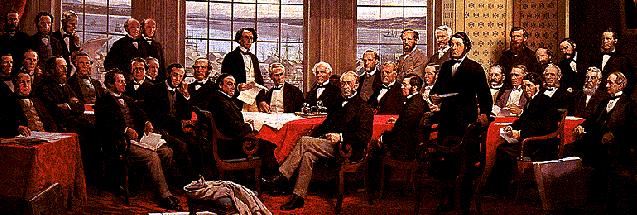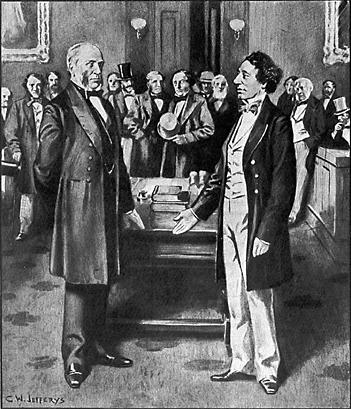What were the steps leading to Confederation
?
The Charlottetown Conference
1864

In September, representatives of the Maritime colonies went to
Charlottetown to discuss a
Maritime Union. The leaders of the colony of Canada asked to be
invited to suggest instead a larger scheme of union, confederation of
the Maritime colonies and the colony of Canada. Representatives from
Canada, both Canada East and West, Nova Scotia, Newfoundland, and New
Brunswick attended. It was decided to continue the talks the
following month in Quebec City.
The Quebec Conference
1864

The Quebec Conference was a
serious discussion of the specific details of Confederation. A major
point of contention was whether the new country should have a
- legislative union where all
the laws are made by the central government or a
- federal union where
the central government makes some laws, but the provinces make
their own laws for local matters.
John A. Macdonald preferred a
legislative union because he saw how a federal union in the USA had
led to civil war. However, it was decided that the new country would
have a federal system of government so that Quebec and the Maritimes
could maintain control over local affairs. Quebec, especially did not
want to lose control over language and religion. It was also decided
that
- the House of Commons would be elected using representation
by population
- there would also be an appointed Senate with equal regional
representation
- Parliament would be made up of three parts, the elected
House of Commons, the appointed Senate, and the monarch,
represented by an appointed Governor-General.
Here is a small part of a CBC Radio
drama depicting the Quebec Conference where the Fathers of
Confederation got together to hammer out a deal. The actor playing
the role of Sir John A, Macdonald -- who was then the Honourable
Member for Kingston-- talks about his idea for a federal union of
British North American colonies. [57Kb]
Reactions
- French Canadian delegates accepted the terms of
Confederation because the province would have control of local
affairs, specifically education and religion. French culture would
thus not be threatened by the bigger English population. However,
les Rouges, led by A.A. Dorion, claimed that Confederation would
mean the end of French Quebec.
- Canada West was happy because George Brown got
rep by pop, and the province
would be able to dominate affairs in the new country. The deadlock
of the previous years would be over.
- Delegates from the Maritimes were not so happy because they
would have little power in the federal government, as they were so
much smaller than Ontario and Quebec in population, but, like
Quebec, they would be able to keep control of local
matters.
At the end of the Quebec Conference the delegates drew up a
list of seventy-two recommendations called the
Quebec or the
72 Resolutions. The political
system adopted at Quebec City is very similar to the system we still
have in Canada today, though much has been added to it.
The delegates would have to explain these recommendations to
the assemblies in each colony and persuade them to pass them, so that
they could then ask the British government to approve the plan for
Confederation. Thanks to the Great Coalition, the plan was swiftly
passed in Canada. There was much opposition in the Maritime colonies.
Newfoundland was not interested from the start. New Brunswick
electors voted Tilley out of office for a while, and Tupper had to
face the determined opposition of Joseph Howe in Nova Scotia.
Eventually, both legislatures voted for confederation. Fenian raids
in New Brunswick showed how weak that colony would be if it tried to
stand alone.
The London Conference
1866
|

|
In 1866, delegates from the three colonies travelled
to London, where the British government approved the plan
for confederation. A law of the British parliament acted as
the constitution of Canada, and this fact was to cause
trouble later, when Canada wanted to have its constitution
as a Canadian law,
not a British law.
On July 1, 1867,
the British North America
Act, commonly called the
BNA Act was
proclaimed.
The original Dominion of Canada had
four provinces,
Ontario, Quebec, New Brunswick and Nova Scotia, but the BNA
Act looked forward to including British Columbia and the
lands of the Hudson's Bay Company.
Its motto, A mari usque ad mare, From sea to
shining sea.
|
Try the following questions on the stages leading to
Confederation.


